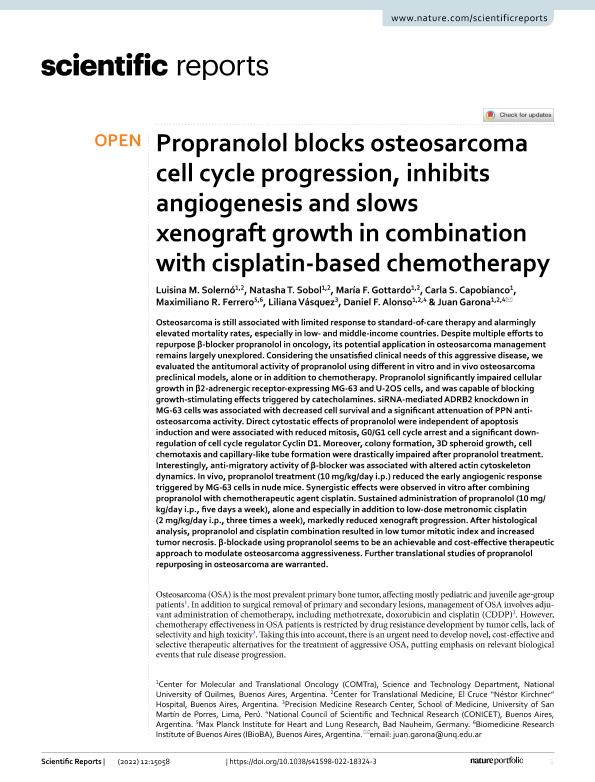Artículo
Propranolol blocks osteosarcoma cell cycle progression, inhibits angiogenesis and slows xenograft growth in combination with cisplatin-based chemotherapy
Solernó, Luisina María; Sobol, Natasha Tatiana ; Gottardo, María Florencia
; Gottardo, María Florencia ; Capobianco, Carla Sabrina
; Capobianco, Carla Sabrina ; Ferrero, Maximiliano Ruben
; Ferrero, Maximiliano Ruben ; Vásquez, Liliana; Alonso, Daniel Fernando
; Vásquez, Liliana; Alonso, Daniel Fernando ; Garona, Juan
; Garona, Juan
 ; Gottardo, María Florencia
; Gottardo, María Florencia ; Capobianco, Carla Sabrina
; Capobianco, Carla Sabrina ; Ferrero, Maximiliano Ruben
; Ferrero, Maximiliano Ruben ; Vásquez, Liliana; Alonso, Daniel Fernando
; Vásquez, Liliana; Alonso, Daniel Fernando ; Garona, Juan
; Garona, Juan
Fecha de publicación:
12/2022
Editorial:
Nature Publishing Group
Revista:
Scientific Reports
ISSN:
2045-2322
Idioma:
Inglés
Tipo de recurso:
Artículo publicado
Clasificación temática:
Resumen
Osteosarcoma is still associated with limited response to standard-of-care therapy and alarmingly elevated mortality rates, especially in low- and middle-income countries. Despite multiple efforts to repurpose β-blocker propranolol in oncology, its potential application in osteosarcoma management remains largely unexplored. Considering the unsatisfied clinical needs of this aggressive disease, we evaluated the antitumoral activity of propranolol using different in vitro and in vivo osteosarcoma preclinical models, alone or in addition to chemotherapy. Propranolol significantly impaired cellular growth in β2-adrenergic receptor-expressing MG-63 and U-2OS cells, and was capable of blocking growth-stimulating effects triggered by catecholamines. siRNA-mediated ADRB2 knockdown in MG-63 cells was associated with decreased cell survival and a significant attenuation of PPN anti-osteosarcoma activity. Direct cytostatic effects of propranolol were independent of apoptosis induction and were associated with reduced mitosis, G0/G1 cell cycle arrest and a significant down-regulation of cell cycle regulator Cyclin D1. Moreover, colony formation, 3D spheroid growth, cell chemotaxis and capillary-like tube formation were drastically impaired after propranolol treatment. Interestingly, anti-migratory activity of β-blocker was associated with altered actin cytoskeleton dynamics. In vivo, propranolol treatment (10 mg/kg/day i.p.) reduced the early angiogenic response triggered by MG-63 cells in nude mice. Synergistic effects were observed in vitro after combining propranolol with chemotherapeutic agent cisplatin. Sustained administration of propranolol (10 mg/kg/day i.p., five days a week), alone and especially in addition to low-dose metronomic cisplatin (2 mg/kg/day i.p., three times a week), markedly reduced xenograft progression. After histological analysis, propranolol and cisplatin combination resulted in low tumor mitotic index and increased tumor necrosis. β-blockade using propranolol seems to be an achievable and cost-effective therapeutic approach to modulate osteosarcoma aggressiveness. Further translational studies of propranolol repurposing in osteosarcoma are warranted.
Palabras clave:
PROPRANOLOL
,
OSTEOSARCOMA
,
DRUG REPURPOSING
Archivos asociados
Licencia
Identificadores
Colecciones
Articulos(IBIOBA - MPSP)
Articulos de INST. D/INV.EN BIOMED.DE BS AS-CONICET-INST. PARTNER SOCIEDAD MAX PLANCK
Articulos de INST. D/INV.EN BIOMED.DE BS AS-CONICET-INST. PARTNER SOCIEDAD MAX PLANCK
Articulos(SEDE CENTRAL)
Articulos de SEDE CENTRAL
Articulos de SEDE CENTRAL
Citación
Solernó, Luisina María; Sobol, Natasha Tatiana; Gottardo, María Florencia; Capobianco, Carla Sabrina; Ferrero, Maximiliano Ruben; et al.; Propranolol blocks osteosarcoma cell cycle progression, inhibits angiogenesis and slows xenograft growth in combination with cisplatin-based chemotherapy; Nature Publishing Group; Scientific Reports; 12; 1; 12-2022; 1-18
Compartir
Altmétricas



